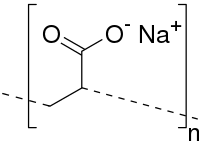
Photo from wikipedia
This project purposes to develop chitosan and sodium alginate–based hydrogel membranes loaded with curcumin through microwave-based physical cross-linking technique and its evaluation for wound healing potential. For the purpose, curcumin-loaded… Click to show full abstract
This project purposes to develop chitosan and sodium alginate–based hydrogel membranes loaded with curcumin through microwave-based physical cross-linking technique and its evaluation for wound healing potential. For the purpose, curcumin-loaded chitosan and sodium alginate membranes were developed using microwave at fixed frequency of 2450 MHz, power 350 W for 60 s, and tested for their physicochemical attributes like swelling, erosion, surface morphology, drug content, and in vitro drug release. The membranes were also subjected to tensile strength and vibrational and thermal analysis followed by testing in vivo on animals. The results indicated that microwave treatment significantly enhanced the swelling ability, reduced the erosion, and ensured smooth surface texture with optimal drug content. The drug was released in a slow fashion releasing total of 41 ± 4.2% within 24-h period with a higher tensile strength of 16.4 ± 5.3 Mpa. The vibrational analysis results revealed significant fluidization of hydrophilic domains and defluidization of hydrophobic domains which translated into a significant rise in the melting temperature and corresponding enthalpy which were found to be 285.2 ± 3.2 °C and 4.89 ± 1.4 J/g. The in vivo testing revealed higher percent re-epithelialization (75 ± 2.3%) within 14 days of the treatment application in comparison to only gauze and other treatments applied, with higher extent of collagen deposition having well-defined epidermis and stratum corneum formation. The microwave-treated chitosan-sodium alginate hydrogel membranes loaded with curcumin may prove to be another alternative to treat skin injuries. Graphical Abstract Graphical Abstract
Journal Title: AAPS PharmSciTech
Year Published: 2022
Link to full text (if available)
Share on Social Media: Sign Up to like & get
recommendations!